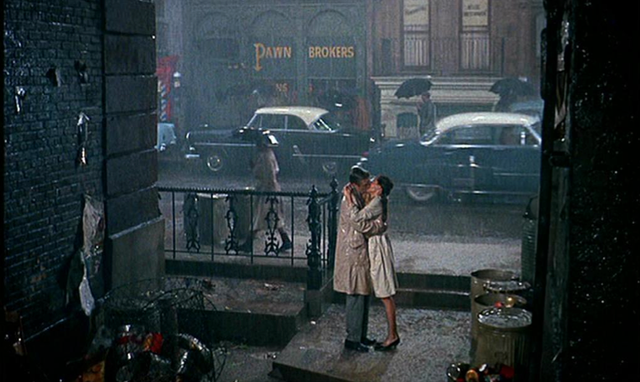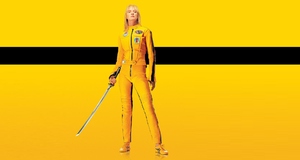Holly Golightly and the Endless Pursuit of Self-Actualization in "Breakfast at Tiffany's"
By
2014, Vol. 6 No. 09 | pg. 3/3 | « In the final sequence, the cinematic object of Tiffany’s undercuts the subversive identity that Holly has developed throughout the film, relocating her within the feminine mystique. Before these final minutes, Holly has strived to remain “elusive, nameless, [and] placeless” in order to self-actualize her identity (Capote 43). As demonstrated by her statement “I’m not Holly, I’m not Lulamae either … I don’t know who I am!” she cannot be assigned a fixed nom du père, in part because she has rejected marriage as being synonymous with imprisonment. In Écrits (1966), Jacques Lacan writes that “the lack of nom du père opens up [a hole] in the signified, and sets off a cascade of reworkings of the signifier from which the growing disaster of the imaginary proceeds” (481). The Name of the Father confers identity and status on the individual within the symbolic order – without which Holly possesses no permissible social role in her male-dominated diegesis. When José da Silva Pereira discovers Holly’s inferior social position, he quickly abandons her, having his “name to protect.” Before her brother Fred’s death, Holly exerted the power of naming by labelling Paul with her brother’s name; in the final sequence, Paul seeks to actualize Holly with the name Mrs. Varjak. In the backseat of a taxi headed for Idlewild Airport, Paul imposes “linguistic command,” repeating “I love you” and “You belong to me” to Holly enough times as if to intentionally conflate them (Mulvey 7). One last time, Holly refuses to ascribe to the pervasive sexual containment policy, arguing that “people don’t belong to people” and that such a commitment between people unavoidably yields a loss of autonomy for one. Paul – frustrated with his seemingly failed attempt to reform her identity – tosses the Cracker Jack ring onto Holly’s lap, falsely asserting, “I don’t want it anymore.” Inevitably, the ring fits perfectly when Holly tries it on for size, and her silent sob conveys the anguish of assimilating to her codified filmic and extradiegetic female role. As Holly leaves the taxi and runs in the opposite direction of Idlewild Aiport, the project of her subversive identity becomes undone. She has entered another scene of commerce – only she is now vulnerable to commodification other than self-commodification. She has inadvertently entered a scene that follows a genre formula in which the male hero wins over the heroine: in summarizing the ultimate moral of Tiffany’s, a Paramount studio executive stated, “Overcoming her fear of life, Holly is eventually able to love and accept the love of just one man” (Kramer 62). Yet, in this final scene, the lover and the romantic commitment seem indistinguishable from the consumer and the commodity. As Holly runs to Paul’s open arms, the mise-en-scène features a proliferation of advertisements signifying the concurrent transaction: “PRICES ARE DOWN,” “BARGAIN CENTER,” “DOLLAR SAVINGS,” and “RESTAURANT FOR RENT.” Holly has been purchased via a male-centered filmic discourse of Hollywood romance, crystallized by a rain-soaked kiss under a “PAWN BROKERS” sign (Fig. 4). Holly no longer stands in front of Tiffany’s in a black satin dress with a hope for upward social mobility and autonomy; now she kisses Paul in an alley, accepting her position in society among the trash of the more privileged. Thus, rather than finishing the project of generating a subversive onscreen female character, Tiffany’s attempts to convince the viewer of the durability of filmic and extradiegetic gender roles – it sells the status quo. 
ConclusionLike a box of Cracker Jack or virtually any mainstream film, Tiffany’s is junk food, ultimately recreational and hardly a political weapon. Often mimetic of social codes and only occasionally toying with them, this pleasantly escapist film perhaps accidentally generated an iconic female persona in Hepburn’s Holly. Contemporary viewers were either bothered or thrilled that Holly had “forsaken her family, abandoned her husband, gone out with a lot of rich foreign men, and, worst of all, had a really good time throughout” (Wasson 178). In the early 1960s, a significant number of viewers might have thought that Holly’s destabilization of the gender roles of “men as breadwinners” and “women as mothers” had the potential to “cause sexual and familial chaos and weaken the country’s moral fiber” if taken seriously (May 117). Even though the Production Code was nearing its end, morality was still policed by mass media, as evinced by a 1962 Irving A. Mandell review: “the Tiffany picture is the worst of the year from a morality standpoint … not only does it show a prostitute throwing herself at a ‘kept’ man but it treats theft as a joke” (Wasson xix). Thus, although the cinematic process of Tiffany’s makes a promise of female self-actualization that is ultimately broken, the film raised a series of controversial questions about gender roles in its time, albeit blithely. As a glossy Hollywood comedy, Tiffany’s cannot engage with the question of how difficult it would have been for Holly to move from Tulip, Texas to the highest echelons of New York City society. She would have been running through a briar patch of forces threatening to contain her within her previous social position. In Being and Nothingness, Jean-Paul Sartre states, “there are indeed many precautions to imprison a man in what he is, as if we lived in perpetual fear that he might escape from it, that he might break away and suddenly elude his condition” (59). As much as Holly may try to subvert the feminine mystique, social precautions have been taken to ensure that she cannot forge a female community and succeed in her transformation. In conclusion, Tiffany's is an intensely ambiguous film – to the point that some critics have labelled it uninterpretable. Imaginably, the viewer might endlessly bounce around within the text without attaining a cohesive underlying meaning – possibly because the film reads as constructed and surface-driven. In an essay on Truman Capote’s novel, Bede Scott asserts that the Tiffany’s narrative “resists interpretation not because of its opacity, its hidden profundities, but because of its transparency … so superficial, so patently ‘just what it is,’ that it immediately invalidates any attempt to burden it with deeper and more substantial meaning” (134). The film’s mutability of meaning allows for Holly to be a two-dimensional “surface” of a character in one viewing and a profoundly tragic figure in the next, thus occupying a liminal space between a celebration and a critique of this woman’s New York City lifestyle. Discussions about Tiffany’s have a tendency to feel interminable: in a debate about Holly, it eventually may seem as if both participants are talking about a female character that barely exists within the film itself. Thus, Holly is prey to being signified by viewers – possibly because the film half-consciously engages with a smorgasbord of different social commentaries, one often opposing the other. In a recent essay, Judith Crist argues that Tiffany’s was a “progressive step in the depiction of women in the movies, perhaps unintended by [screenwriter] Axelrod and [director] Edwards” (Wasson 167). Thus, how should the modern viewer approach a text that may be unintentionally proto-feminist? This essay argues that Tiffany’s merits interpretation because it engages with the notion that women in male-dominated society are under constant surveillance, perpetually actualized from outside. Thus, the transience and ultimate failure of Holly’s self-actualized identity has broad – and disappointingly realistic – implications for women living in urban consumer culture. ReferencesCapote, Truman. Breakfast at Tiffany's: A Short Novel and Three Stories. New York: Random House, 1958. Cohen, Marilyn. “Breakfast at Tiffany’s: Performing Identity in Public and Private.” Ed. Fiona Fisher. Performance, Fashion and the Modern Interior: From the Victorians to Today. London: Berg, 2011. Debord, Guy. Society of the Spectacle. Detroit: Black and Red, 1983. Douglas, Susan J. Where the Girls Are: Growing up Female with the Mass Media. New York: Times, 1994. Friedan, Betty. The Feminine Mystique. New York: W.W. Norton, 1963. Goffman, Erving. The Presentation of Self in Everyday Life. New York: Doubleday Anchor, 1959. Inge, M. Thomas., ed. Truman Capote: Conversations. Jackson: U of Mississippi, 1987. Kramer, Peter. “The Many Faces of Holly Golightly: Truman Capote, Breakfast at Tiffany’s and Hollywood.” Film Studies 5 (2004): 58-65. Lacan, Jacques. Ecrits: The First Complete Edition in English. Trans. Bruce Fink. New York: W.W. Norton, 2006. May, Elaine Tyler. Homeward Bound: American Families in the Cold War Era. New York: Basic, 1988. Mulvey, Laura. "Visual Pleasure and Narrative Cinema." Screen 16.3 (1975): 6-18. Scott, Bede. “On Superficiality: Truman Capote and the Ceremony of Style.” Journal of Modern Literature 34.3 (2011): 128-48. Wasson, Sam. Fifth Avenue, 5 A.M.: Audrey Hepburn, Breakfast at Tiffany’s, and the Dawn of the Modern Woman. New York: HarperStudio, 2010. Wegener, Signe O. James Fenimore Cooper versus the Cult of Domesticity: Progressive Themes of Femininity and Family in the Novels. Jefferson, NC: McFarland, 2005. Wojcik, Pamela Robertson. The Apartment Plot: Urban Living in American Film and Popular Culture, 1945 to 1975. Durham: Duke UP, 2010. Works Consulted Beauvoir, Simone De. The Second Sex. New York: Vintage, 1989. Carson, Diane, Linda Dittmar, and Janice R. Welsch, eds. Multiple Voices in Feminist Film Criticism. Minneapolis: University of Minnesota, 1994. Humm, Maggie. Feminism and Film. Indianapolis: Indiana UP, 1997. Endnotes1.) Also known as the “Cult of True Womanhood,” this value system was first identified in the mid-nineteenth century among the upper and middle classes in the United States and Great Britain. 2.) Ironically, Truman Capote, the author of the Tiffany’s novella, had Monroe in mind when developing Holly as a character. Monroe ultimately turned down the role after being advised by her acting teacher Lee Strasberg that playing a prostitute would be detrimental to her image. 3.) May argues that this “sexual containment policy” was partly a response to Alfred Kinsey’s 1948 and 1953 reports of widespread premarital sex and masturbation among American men and women. 4.) It might be argued that, with this statement, Sally invites writer Paul to begin authoring or actualizing Holly’s identity – foreshadowing the film’s final scene.
Suggested Reading from Inquiries Journal
Inquiries Journal provides undergraduate and graduate students around the world a platform for the wide dissemination of academic work over a range of core disciplines. Representing the work of students from hundreds of institutions around the globe, Inquiries Journal's large database of academic articles is completely free. Learn more | Blog | Submit Latest in Film & Media |


















